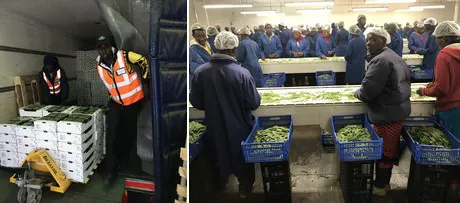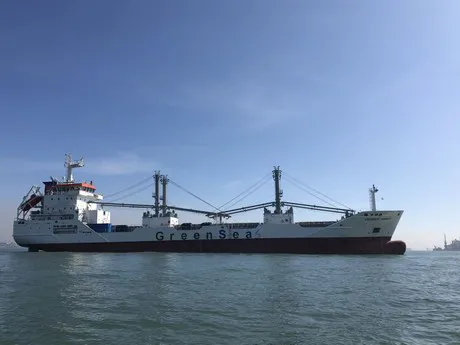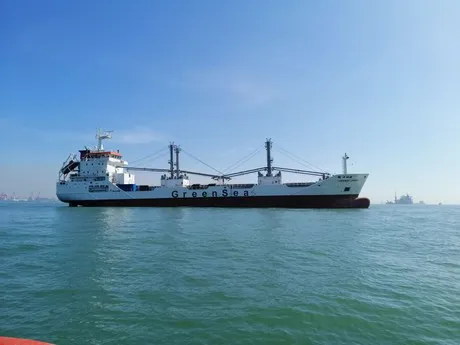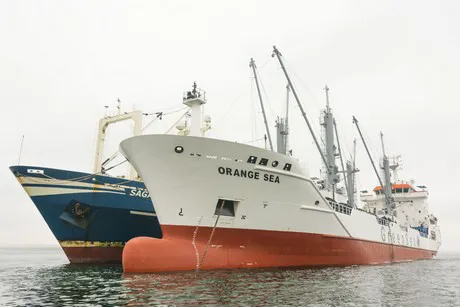Retailers in Europe increasingly prefer seaborne freight, according to Carel van Oosterzee, Programme Manager of PUM. PUM combines the forces of 2,000 senior experts – financed by employee’s association VNO-NCW and the Ministry of Foreign Affairs – who share their experience with entrepreneurs in developing countries and emerging markets. On behalf of PUM, Carel supports Zimtrade, the national organisation for trade development and advancement in Zimbabwe, in improving the sales supply chain. Because although seaborne freight guarantees much lower prices – “60 per cent cheaper,” Carel says – and more sustainable transport – “factor 50” – than air freight, the choice for seaborne freight can’t always be made. Transit time could be too long, for instance, or the product to be transported not strong enough.
Due to its unique climate, Zimbabwe is capable of supplying products when other countries can’t. For example, in spring, Zimbabwe can exclusively supply snow peas for about five months. They have blueberries in October and November. Their avocados are ripe earlier than in neighbouring country South Africa. A wonderful economic start, but their supply chain isn’t in their favour.

Transit time reduced
“When we started this project two years ago, the transit time for seaborne freight to Europe was 32 days,” Carel says. This has now been reduced to 24 days, and an optimisation of one or two days might still occur as well. To achieve this, the entire supply chain has been mapped. A small company, for example, can take ten days to fill a container with snow peas. That’s too long to ship a good product. As a result, seaborne freight was reserved for a few large companies, while demand to import more sustainable fruit and vegetables increases from European retailers, Carel explains. The programme has selected three mid-sized growers as model farms. These work locally with smaller growers in the field of knowledge and infrastructure. That way, it’s also feasible for small growers to export and fill a container in a day and a half.
Optimisation of transport to the port was also looked into. The closest port is Cape Town, and is about 2,500 kilometres away. To reach it, lorries are used. By tracking and tracing, transport is mapped, and the quickest route can be found. Conditioned transport has now become standard as well. “In the past, the growers regularly saved on using cooled lorries.” The central sales point in Zimbabwe has been renovated as well, and there are plans to replace it with a modern cooling facility suitable for all types of transport in the long term.

Quickest departure
Due to wait times and delays, ships don’t always depart according to schedule. That’s why they look into which shipping company has the earliest departure just before the products reach Cape Town. “If you put the products in a Maersk container, and the boat has just left, you might have to wait a week for the next boat. We use, for example, a grape packing station that’s empty during the snow pea season, to transfer products to a container of the shipping company that leaves first.
On the production side of things, a programme was set up in cooperation with agriculturalists to produce a stronger product and thus extend shelf life. This involves aspects like seed and seed crop selection, irrigation, sustainable energy, crop protection, post-harvest treatment and fertilisation. Carel indicates that if the product is stronger, the decision between air and seaborne cargo can be made. “There could be reasons to choose the air, after all. At the start of the season, for example, when demand is high and the product isn’t as strong yet. Once supply is going well, there’s nothing to stop you from choosing seaborne freight.” The expectation of the market is that 75 per cent will eventually be exported via seaborne freight, and 25 per cent via the air.

Increase in export
Carel has noticed export from Zimbabwe increasing. Demand has risen and Zimbabwe can now also meet demand for ocean transport. Carel has also noticed that improvements introduced by PUM play a part in demand for retailers as well. “It provides the European market with an additional choice regarding where to buy their products. Because this also involves a social aspect, it’s interesting for European parties to enter into business agreements with these companies.”
Challenging destination
Although exporters from Zimbabwe are doing everything to adapt infrastructure to enable sea transport per container, the lack of said infrastructure turns out to be a starting point for transport per reefer ship. “The more challenging the destination, the more we prefer it,” says Hans Mol, Manager of GreenSea Chartering – a cooperation between Seatrade and Green Reefers with a fleet of 45 conditioned ships active in the transport of breakbulk goods such as, for example, (seed) potatoes, citrus and fishing products. He says that despite the global containerisation of seaborne transport, there’s a good group of customers left for the reefer ships, and that it’s still a good way of earning a living. “Transport per container has all manner of advantages, but we can exist side by side.”
Products that are suitable for transport per reefer ship are mostly products with short and intense seasons with receiving ports that lack the necessary infrastructure. Examples are seed potatoes from the Netherlands and Northwestern Europe to Algeria, Libya or Tunisia, or citrus from Morocco to the Baltic countries. GreenSea also transports potatoes from Egypt to Russia. GreenSea mostly works with partner Seatrade in the field of fruit.

Green ships
GreenSea invests in the rejuvenation and renewal of its fleet. In the past eight months, six new reefer ships were taken into use. Hans mentions that the fleet is and continues to be GreenSea’s most important focus. “We want to be an independent transporter, our investments will always be in our boats. We won’t make investments in infrastructure on the land-side of things.” The new boats were built to transport cold products as energy-efficiently as possibly, according to Hans. They use as little fuel as possible to create a minimum amount of emissions. Compared to the existing boats, that could save five to six tonnes of fuel per day, which amounts to a saving in fuel of 30 to 35 per cent. Although boats were built to be as fast as possible in the past, focus is nowadays on efficiency much more. “The hull was designed to glide through the water as efficiently as possible. Fuel is expensive and we’ve all become more environmentally aware.”
Continuing to renew
Efficiency is a key concept within GreenSea. “It’s all about efficiency, after all, we have competition from containers, and that partly decides the price we can ask for,” Hans says. That means, among other things, that attention is paid to the speed of loading and unloading. GreenSea personally takes care of the unloading process in a number of countries to keep the unloading speed under control. Relationships with customers also play a major part. “We’re close to our customers, and we try to understand what they’re doing.” As a result, GreenSea can respond to an earlier or later start of a season and its intensity. “We continue to play a role in that, this type of season specifically, short, intense and with a challenging infrastructure. That’s what we focus on.”
Continuing to renew the reefer fleet is challenging for the entire industry, according to Hans. The average age of the reefer fleet in Asia is considerably higher, for example. “If nothing’s done about that, it would result in opportunities for us, and we’re already noticing that now. On the other hand, we’re limited in what we can do as well. The last thing we want is shipments ending up in containers after all, because there are no other alternatives anymore.” Hans expects there will always be demand for this type of transport for specific shipments, and he calls on the entire industry to keep their fleets up to date.
For more information:
Carel van Oosterzee
PUM
Email: carel.van.oosterzee@pum.nl
Hans Mol
GreenSea
Email: hans.mol@greensea.be
